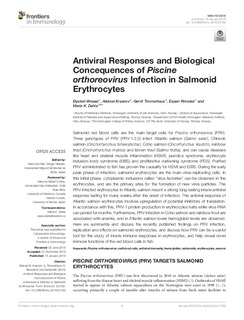| dc.description.abstract | Salmonid red blood cells are the main target cells for Piscine orthoreovirus (PRV). Three genotypes of PRV (PRV-1,2,3) infect Atlantic salmon (Salmo salar), Chinook salmon (Onchorhynchus tshawytscha), Coho salmon (Oncorhynchus kisutch), rainbow trout (Onchorhynchus mykiss) and brown trout (Salmo trutta), and can cause diseases like heart and skeletal muscle inflammation (HSMI), jaundice syndrome, erythrocyte inclusion body syndrome (EIBS) and proliferative darkening syndrome (PDS). Purified PRV administrated to fish has proven the causality for HSMI and EIBS. During the early peak phase of infection, salmonid erythrocytes are the main virus-replicating cells. In this initial phase, cytoplasmic inclusions called “virus factories” can be observed in the erythrocytes, and are the primary sites for the formation of new virus particles. The PRV-infected erythrocytes in Atlantic salmon mount a strong long-lasting innate antiviral response lasting for many weeks after the onset of infection. The antiviral response of Atlantic salmon erythrocytes involves upregulation of potential inhibitors of translation. In accordance with this, PRV-1 protein production in erythrocytes halts while virus RNA can persist for months. Furthermore, PRV infection in Coho salmon and rainbow trout are associated with anemia, and in Atlantic salmon lower hemoglobin levels are observed. Here we summarize and discuss the recently published findings on PRV infection, replication and effects on salmonid erythrocytes, and discuss how PRV can be a useful tool for the study of innate immune responses in erythrocytes, and help reveal novel immune functions of the red blood cells in fish. | nb_NO |

